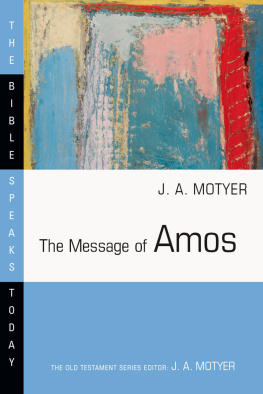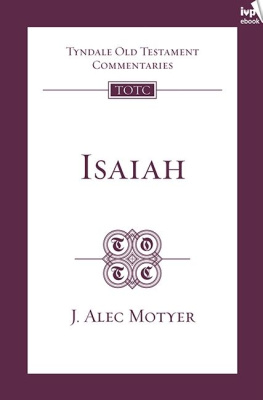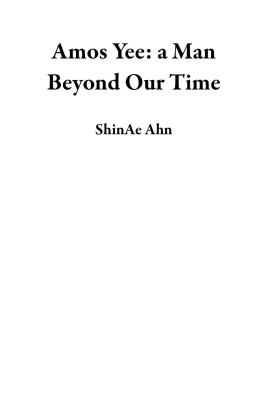THE BIBLE SPEAKS TODAY
The Message of Amos
J. A. MOTYER
InterVarsity Press, USA
P.O. Box 1400
Downers Grove, IL 60515-1426, USA
World Wide Web: www.ivpress.com
Email:
J. A. Motyer 1974. Originally published under the title The Day of the Lion.
All rights reserved. No part of this publication may be reproduced, stored in a retrieval system or transmitted in any form or by any means, electronic, mechanical, photocopying, recording or otherwise, without the prior permission of InterVarsity Press.
InterVarsity Press, USA, is the book-publishing division of InterVarsity Christian Fellowship/USA and a member movement of the International Fellowship of Evangelical Students.
The Scripture quotations quoted herein are from the Revised Standard Version of the Bible, copyright 1946, 1952, 1971, 1973, by the Division of Christian Education of the National Council of the Churches of Christ in the U.S.A. Used by permission. All rights reserved.
Design: Cindy Kiple
Image: Marilee Whitehouse-Holm/Getty Images
ISBN 978-0-8308-8315-8 (digital)
ISBN 978-0-87784-283-5 (print)
This digital document has been produced by Nord Compo.
TO
Mark
9 August 1973
Stephen and Valerie
11 August 1973
Beryl
30 August 1973
The Bible Speaks Today
Series editors: J. A. Motyer (OT)
John R. W. Stott (NT)
The Message of Amos
The Day of the Lion
General preface
The Bible Speaks Today describes a series of both Old Testament and New Testament expositions, which are characterized by a threefold ideal: to expound the biblical text with accuracy, to relate it to contemporary life, and to be readable.
These books are, therefore, not commentaries, for the commentary seeks rather to elucidate the text than to apply it, and tends to be a work rather of reference than of literature. Nor, on the other hand, do they contain the kind of sermons which attempt to be contemporary and readable, without taking Scripture seriously enough.
The contributors to this series are all united in their convictions that God still speaks through what he has spoken, and that nothing is more necessary for the life, health and growth of Christians than that they should hear what the Spirit is saying to them through his ancientyet ever modernWord.
J. A. MOTYER
J. R. W. STOTT
Series Editors
Authors Preface
A MOS must have put in hours of study before he went preaching in Bethel. He took the trouble to become well-informed about world history and current affairs, so that he was able to capture and hold his audiences attention by deft allusions to surrounding nations. How his hearers must have loved it, until it came too close to home for comfort! But that too was part of the slog of preparation: his sermons were so well and so cleverly constructed, with closely-argued points made in such ways and in such sequence that the whole had a compelling cogency. Amaziah, that worldly ecclesiastic, saw the mind of the nation coming under Amos spell, and even if his judgment was suspect about other things, at least here he could be trusted to take the national temperature.
What a pity, then, that Amos left us only the distilled essence of what he said and not his sermons in their full development and application! Look at it this way: suppose we think of i: 33:2 as one discourse. It can be read in five minutes without undue haste, but it could not be preached as it stands. It covers too much ground too quickly; no mind could follow or grasp what was being said. To affect his hearers, Amos must have developed his themes, made his connections clear, opened and applied his message, and rubbed it home. But all he left us was his notes.
There are therefore two tasks to be performed on any passage from the prophets. The first is exegesis: to elucidate what is there, to establish the meaning of each word, to balance shades of meaning against each other, to explore grammar and syntax, until, as clearly and confidently as may be, we can believe that we know what it was Amos said. The secondand consequenttask is exposition. Starting from the meaning which nas been established, exposition seeks to draw it out into a total message so that we today begin to feel its truth coming home to us with force and application.
But the point to be insisted on is this, that both exegesis and exposition are serious exercises in Bible study. They are not sworn enemies, as the jargonistic distinction between academic and devotional would have us believe; neither is the poor relation of the other. Exegesis without exposition is like a deepfreeze, full of good things but, as it stands, out of touch with reality and devoid of nourishment; exposition without exegesis is like a space-rocket, enjoying itself in its own orbit but oblivious now of the launching-pad from which it started.
My aim in this book is exposition. I trust that I have not skimped the task of exegesisindeed I have ventured to show some of the workings in the margin, and some more in the commentary on Amos in NBCR (though on some points it will be noted that I have changed my mind)but I have laboured to clothe the bones of exegesis with the flesh of exposition whereby Amos may again speak to the church.
His message is relevant, humbling and frightening. It rebukes the eleven and six-thirty of our formalism; it offers the salutary reminder that a tradition of the church may have lasted two hundred years only to be as false at the end as it was at the beginning; it insists that the church loses the centrality of the Word of God to its eternal peril; it exposes the sin of religious self-pleasing; it describes a religion which is abhorrent to God and calls for its replacement by a resting upon divine grace in faith and repentance, a commitment to Gods law in obedience, and a ceaseless concern for the needy among men. Without these, there is nothing so effective as religion to separate us from Gods love and to cement us to His wrath.
Expositions should grow out of pulpit work. St Lukes, Hampstead, gave me a choice proving-ground for what has finally become this book. St Helens, Bishopsgate, lent a helpful ear to a refashioned form of the material. After I had tried to cover the whole book in five studies at the Keswick Convention in 1970, the rumour flew round that by now even Amos was saying that he was sorry he had written it in the first place! I hope this is not true, even though, having now spent a great deal of time in the company of this gentle giant among the prophets, I can only testify to feeling like a very small mouse who has had the good fortune to nibble at a very large and nourishing cheese.
May He who is Amos God and mine graciously stoop to use this book for the benefit of His church!
Trinity College, Bristol. August 1973 | J. A. MOTYER |
Chief Abbreviations
BDB | Hebrew and English Lexicon of the Old Testament by F. Brown, S. R. Driver and C. A. Briggs (OUP, 1906). |
BHS | Biblia Hebraica Stuttgartensia: Liber XII Prophetarum praeparavit K. Elliger (Stuttgart, 1970). |
Cripps | A Critical and Exegetical Commentary on the Book of Amos by R. S. Cripps (2nd ed., SPCK, 1955). |
Hammershaimb | The Book of Amos: A Commentary |














